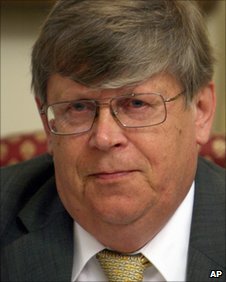
In light of the amazingly dramatic reveal of an Iranian plot to kill the Saudi Ambassador to the U.S. at his favorite DC dinner spot using a Mexican drug cartel gun for hire (calling Robert Ludlum!), I thought it pertinent to cite a recent Der Speigel interview with former IAEA Deputy Director for Safeguards Olli Heinonen. In the interview, Heinonen, now at Harvard, provides some really fascinating insights into countries of proliferation concern based on his IAEA stint, including Iran, North Korea, and Pakistan, as well as the Fukushima situation. With 27 years at the Agency, including as an inspector at Yongbyon, Heinonen is really someone to listen to on this subject.
In the two-parter, Heinonen reflects on the status of Iran’s nuclear program and action during his tenure in Vienna: “I have to say that we allowed ourselves to be placated too often. We should have done more than carrying out our inspections.” Compared to 2003, when the Natanz facility was uncovered, Heinonen concludes that “Today the facts are as follows: The conversion plant in Isfahan has produced 371 tons of uranium hexafluoride. Some 8,000 centrifuges in Natanz are being used to enrich this raw material. In February 2010, Iran began increasing enrichment to 20 percent. That’s a significant step closer to making an atomic bomb because it takes only a few months to turn that into weapons-grade material.”
When asked if there is a “smoking gun” regarding Iran’s quest for the bomb, he replies that “In early June, [Fereydoun] Abbasi announced that Iran was moving the 20-percent enrichment of uranium from Natanz to Fordow, where they are tripling production. Incidentally, the construction of the Fordow plant near Qom was so shrouded in secrecy that the Iranian authorities first admitted it existed less than two years ago….You don’t need 20-percent enriched uranium to generate electricity for light bulbs. And, in any case, the produced volumes far exceed what Iran might possibly need for its research reactor. What’s more, Tehran has announced that it intends to build 10 more enrichment plants, and Iranian experts have conducted experiments with neutron sources and highly explosive detonators that would only make sense for military applications. They’re also making progress at the heavy-water reactor in Arak, so much so, that by 2014 they’ll have enough plutonium to build an atom bomb.” So, in short, no need for a smoking gun. Its already smoking, according to Heinonen.
On North Korea, he concludes that “The regime clearly considers the atom bomb to be a kind of life insurance policy.” Heinonen spent several months there as an IAEA inspector in the 1990s before the DPRK withdrew from the NPT. “There wasn’t any heating, even in the bitterly cold winter, and we had to go to great lengths to have heaters flown in. Even the vodka distilled on the site did little to offset the cold. Everything was fine while we were able to keep an eye on things.”
Of the A.Q. Khan affair, Heinonen does not mince words about who he believes was involved: ” Of course Khan was the worst black marketeer and made millions from it. Even so, it’s quite possible that others — for instance Pakistani generals or leading secret-service officials — profited even more than Khan did. It’s more than likely that his country’s political authorities were often aware of his dealings.”